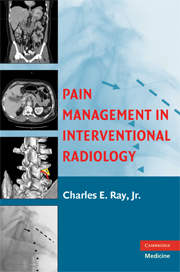1 - Pain Management in Interventional Radiology: An Introduction
Published online by Cambridge University Press: 04 September 2009
Summary
THE PROBLEM OF PAIN
The management of pain continues to be one of the most vexing of problems for health practitioners worldwide. The pain response is difficult to manage for multiple reasons: responses vary widely in their mechanism of action as well as anatomic location; individual responses to pain are variable; secondary gains can be had by individuals falsely claiming to be in pain; cultural differences in description of pain and the willingness to admit to a pain response exist; even responses by the health care provider to a patient in pain varies widely. For these reasons, each and every patient who presents with pain, or in whom we as health care providers are likely to produce a painful response during a procedure, has a widely variable and largely unpredictable pain response.
Traditional medicine (so-called Western medicine) has demonstrated great advances in the management of pain; however, the advances have been relatively few and far between. Opium was cultivated for recreational use by the Sumerians nearly 5,000 years before it was first introduced specifically for medicinal purposes (1). It was not until 1680 that opium was introduced in England as Laudanum, a combination of opium, herbs, and sherry, specifically to be used for medicinal purposes. Although likely poorly understood at the time, the pain-relieving effects of opium must have significantly contributed to the use of opium as a medicinal agent.
- Type
- Chapter
- Information
- Pain Management in Interventional Radiology , pp. 1 - 7Publisher: Cambridge University PressPrint publication year: 2008



